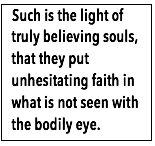|
The
Lord Jesus was taken up into heaven and
is seated at the right hand of God.
The sacred work of our salvation was of such value in the sight of the Creator
of the universe that he counted it worth the shedding of his own blood.
From
the day of his birth until his passion and death this work was carried out
in conditions of self-abasement; and although he showed many signs of his divinity
even when he bore the form of a slave, yet, strictly speaking, the events of
that time were concerned with proving the reality of the humanity he had assumed.
But he was innocent of any sin, and so when death launched its attack upon
him he burst its bonds and robbed it of its power. After his passion weakness
was turned into strength, mortality into eternal life, and disgrace into glory.
Of
all this our Lord Jesus Christ gave ample proof in the sight of many, until
at last he entered heaven in triumph, bearing with him the trophy of his victory
over death.
 And so while at Easter it was the Lord’s resurrection which was the cause of
our joy, our present rejoicing is on account of his ascension into heaven.
With all due solemnity we are commemorating that day on which our poor human
nature was carried up in Christ above all the hosts of heaven, above all the
ranks of angels, beyond the highest heavenly powers to the very throne of God
the Father. And so while at Easter it was the Lord’s resurrection which was the cause of
our joy, our present rejoicing is on account of his ascension into heaven.
With all due solemnity we are commemorating that day on which our poor human
nature was carried up in Christ above all the hosts of heaven, above all the
ranks of angels, beyond the highest heavenly powers to the very throne of God
the Father.
It is upon this ordered structure of divine acts that we have been
firmly established, so that the grace of God may show itself still more marvelous
when, in spite of the withdrawal from our sight of everything that is rightly
felt to command our reverence, faith does not fail, hope is not shaken, charity
does not grow cold.
For such is the power of great minds, such is the light of truly believing souls,
that they put unhesitating faith in what is not seen with the bodily eye; they
fix their desires on what is beyond sight.
Such fidelity could never be born
in our hearts, not could anyone be justified by faith, if our salvation lay
only in what was visible.
This is why Christ said to the man who seemed doubtful
about his resurrection unless he could see and touch the marks of his passion
in his very flesh: “You believe because you see me; blessed are those who
have not seen and yet believe.”
It was in order that we might be capable of such blessedness that on the fortieth
day after his resurrection, after he had made careful provision for everything
concerning the preaching of the gospel and the mysteries of the new covenant,
our Lord Jesus Christ was taken up to heaven before the eyes of his disciples,
and so his bodily presence among them came to an end.
From that time onward
he was to remain at the Father’s right hand until the completion of the period
ordained by God for the Church’s children to increase and multiply, after which,
in the same body with which he ascended, he will come again to judge the living
and the dead.
And so our Redeemer’s visible presence has passed into the sacraments. Our
faith is nobler and stronger because sight has been replaced by a doctrine
whose authority is accepted by believing hearts, enlightened from on high.
(Sermon 74, 1-2: CCL 138A, 455-57)
Leo
the Great (c. 400-61) was elected pope in 440. At a
time of general disorder he did much to strengthen the
influence of the Roman see. Although he was not a profound
theologian, Leo’s teaching is clear and forceful. His Tome
was accepted as a statement of Christological orthodoxy
at the Council of Chalcedon (451). One hundred and forty-three
of his letters and ninety-six sermons have survived. The
latter, which cover the whole of the liturgical year, have
been published in a critical edition.
|